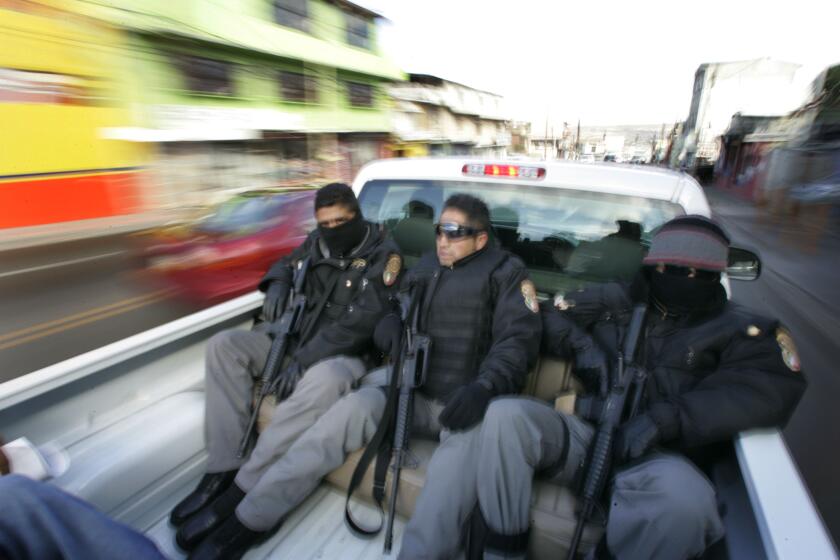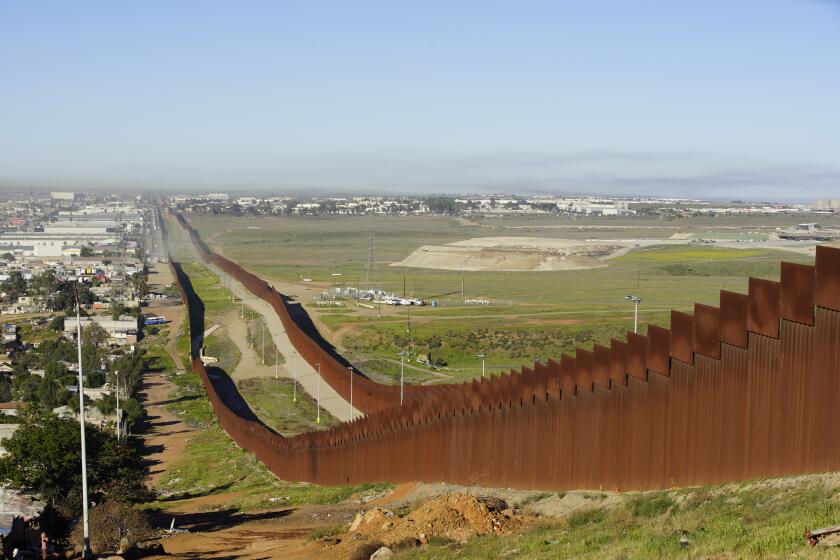Cross-border airport plan clears hurdle
A groundbreaking plan for a privately funded international port of entry linking San Diego directly to Tijuana’s A.L. Rodriguez International Airport appears to have cleared its final hurdle.
Once built, it would allow departing airline passengers to park their cars in San Diego and walk across a bridge to board a plane in Tijuana. For arriving passengers, it would provide a U.S. Customs inspection facility that allows them to cross directly to the United States from the Tijuana airport, and thus avoid lengthy waits at the San Ysidro and Otay Mesa ports of entry.
The project’s U.S. developer, Otay-Tijuana Venture, has agreed to build the Customs inspection facility and pay for staffing, said R. Gil Kerlikowske, newly named commissioner of U.S. Customs and Border Protection.
“My understanding is that the Department of State notified the government of Mexico about the construction that will occur beginning in May,” Kerlikowske said Thursday in an interview before a binational round-table discussion hosted by the South County Economic Development Council.
The new port of entry, unique on the U.S.-Mexico border, is a for-profit private venture that would be financed through toll-paying ticketed airline passengers who fly into and out of the Tijuana airport.
Plans call for a 525-foot long pedestrian bridge leading from the Tijuana airport terminal to a 65,000-square foot structure on the U.S. side that includes an inspection area staffed seven days a week by CBP officers.
The U.S. development group, spearheaded by Chicago real estate mogul Sam Zell, has maintained a low profile on the project in recent months, and did not respond to requests for comment Thursday.
The company previously projected a 15-month time frame to build the cross-border facility, and barring delays, it would be completed in the summer of 2015. A spokeswoman for the group has estimated that the tolls would cost anywhere from $13 to $17 per passenger.
Initially, the facility would be staffed 20 hours a day, said Pete Flores, director of field operations for CBP in San Diego, but that could change according to the demand.
“We’ve created a new port of entry in essence,” Flores said. The agency has been looking for ways to relieve congestion at ports of entry with limited funding, and pre-clearance facilities and innovative proposals involving the private sector increasingly seen as a solution.

The privately funded international port of entry - will link san diego directly to tijuana’s international airport. It would allow airline passengers - to park their cars in san diego - and walk across a bridge to board a plane in mexico. Returning
Negotiations with the developer took more than two years, and included issues such as the construction, design and who would pay the salaries and benefits of the CBP inspectors, Flores said. The final agreement was reached last month.
“We want to be efficient, but we have a security mission, first and foremost, designing this facility with security in mind,” he said.
Launched in 2008 with the purchase of a 58-acre site abutting the border, the project has required multiple government permits on both sides, including presidential permits from both the United States and Mexico to allow construction a new border crossing.
The project “is a reflection that we truly are a binational region,” Cindy Gompper-Graves, chief executive of the South County Economic Development Council, “It gives us easy access to new air travel markets that are not easily served by San Diego.”
She and other champions of the project hope it will open new investment possibilities in the region.
Operators of the Tijuana airport, Grupo Aeroportuario del Pacifico, estimate that more than half of its passengers come from California, drawn by lower airfares but also its wide range of Mexican connections. The Tijuana airport offers direct flights to Shanghai and Tokyo, but its main market is in Mexico, serving destinations such as Mexico City, Guadalajara, Culiacán, Leon, Morelia, Hermosillo and Veracruz.
The project is being carried out in conjunction with Grupo Aeroportuario del Pacifico, or GAP, a Mexican holding company that operates the Tijuana airport and others across Mexico. GAP is investing some $13.5 million in the project, to expand the Tijuana terminal and build a section of the bridge, and began construction last September.
Previous estimates have put the price tag for the U.S. component of the project at $78 million, a sum that includes the purchase of the land, construction of the bridge, and of a mixed-use structure that would include parking space, shops, restaurants, and the Customs and Border Protection facility.
“All these new people will see the Tijuana airport as an option,” said Alejandra Mier y Teran, executive director of the Otay Mesa Chamber of Commerce. “People who might not be open to going to Tijuana will feel comfortable going to the airport, going into Mexico,” she said. “Then they’ll see how wonderful it is, and want to be tourists there.”
Despite being broadly endorsed by business and political leaders in San Diego, the project has had its detractors in Tijuana. GAP, the airport operator, has had a long-running legal dispute with Tijuana’s municipal government, which claims it is due property taxes. GAP says that since it is on leased federal land, it is not subject to the city tax.
The plan has also been opposed by taxi drivers and other small businesses who say they would be hurt by the project.
“There’s still a feeling in Tijuana, ‘What’s in it for them, that the airport is only going to benefit Americans,’ which is not really true,” said James Clark, director of the Smart Border Coalition, a binational group that lobbies for more efficient border crossings. The crossing will bring more passengers to the airport, Clark said: “I don’t know how that translates into jobs, but it should be a lot of jobs.”
Enrique Esparza, chairman of the Tijuana Economic Development Corporation, or DEITAC, said his group welcomes the project. “Absolutely, it’s something positive,” he said. “It’s a very practical way of getting back and forth across the border and opening up the routes that the Tijuana airport has.”
Get Essential San Diego, weekday mornings
Get top headlines from the Union-Tribune in your inbox weekday mornings, including top news, local, sports, business, entertainment and opinion.
You may occasionally receive promotional content from the San Diego Union-Tribune.











